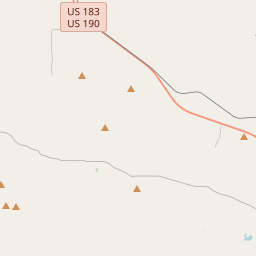Site of Park Hotel
Historical marker location:












The year 1882 ushered in an era of prosperity for Lampasas, as the city became the western terminus for the Gulf, Colorado & Santa Fe line out of Galveston. The city became a trading point for settlers who came for access to the rail line. Known for the curative powers of its local spring water, Lampasas also became a destination for those seeking health and relaxation. A group of businessmen from the Houston and Galveston area built the Grant Park Hotel (Park Hotel), to capitalize on the city’s popularity. The Park Hotel opened in 1883. The two-story frame structure stretched more than 300 feet and overlooked lawns that sloped to Sulphur Creek. The resort offered 200 guest rooms and cabins for families as well as single men, who were housed on Bachelor’s Row. Guests found entertainment in the dining room, parlors, ballrooms and an outdoor bandstand, and used bathing facilities to enjoy the mineral springs. Occupants participated in shooting contests, horseracing, boating and other pursuits; a mule-drawn trolley carried them back and forth between the hotel and the railroad depot. The Park Hotel also became the site for organization meetings, including the first convention of the Texas Bankers Association, founded in 1885 by Frank Malone, a Lampasas banker. The Hotel’s glory days were short lived. By the 1890s, when the rail line had been extended farther west and medical advances surpassed the need for curative waters, the city faced a recession. In 1891, the hotel became part of the Keely Institute. It changed hands twice more before burning to the ground in February 1895. Today, only the stone portions of the bathhouses remain at the site, reminders of a glamorous period in Lampasas history
As one of the most visible programs of the Texas Historical Commission (THC), historical markers commemorate diverse topics in Texas history, including: the history and architecture of houses, commercial and public buildings, religious congregations, and military sites; events that changed the course of local and state history; and individuals who have made lasting contributions to the state, community organizations, and businesses.
The cattle industry played a significant role in the development of Texas, with cowboys driving cattle from Texas to railheads in Kansas during the late 1800s and early 1900s.
In 1852, Lampasas County was officially established, named after the Lampasas River that runs through the area. The county quickly became a prominent agricultural region, with cotton being the primary crop. The arrival of the Texas and Land Company railroad in 1882 further stimulated the local economy, as it facilitated trade and transportation in the area.
During the late 19th and early 20th centuries, Lampasas County also experienced economic growth due to the discovery of mineral resources. Manganese and zinc mining industries played a significant role in the county's development. Additionally, the city of Lampasas became a popular health resort destination, thanks to the therapeutic value of the local natural springs.
Throughout the years, Lampasas County has faced its fair share of challenges. The region went through difficult times during the Great Depression, with the decline of the agricultural industry. However, the county managed to bounce back and diversify its economy, embracing tourism and other industries. Today, Lampasas County remains a vibrant community with a blend of historical charm and modern development.
Lampasas County Timeline
This timeline provides a condensed summary of the historical journey of Lampasas County, Texas.
- 1854 - Lampasas County is founded and named after the Lampasas River.
- 1872 - The town of Lampasas becomes the county seat.
- 1882 - The Gulf, Colorado and Santa Fe Railway is completed through the county.
- 1885 - The first oil well in central Texas is drilled in Lampasas County.
- 1922 - The Hancock Springs Hotel, a popular health resort, is built.
- 1949 - The Fort Hood military reservation is established, impacting the county's economy.
- 1960s - The construction of the Highland Lakes dams brings tourism and recreation to the area.
- 1990s - The county experiences population growth and increased development.